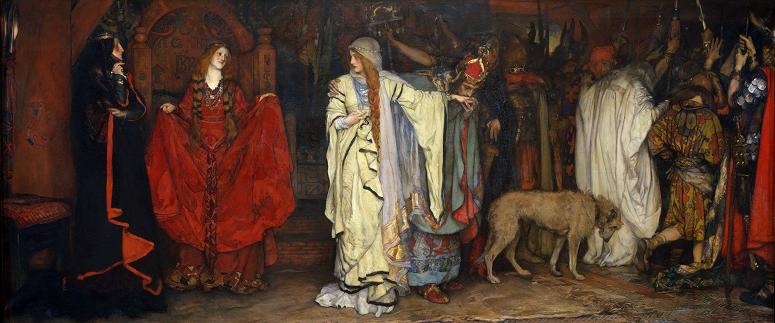Edwin Austin Abbey (1852 - 1911). Edwin Austin Abbey was an American muralist, illustrator, and painter. He flourished at the beginning of what is now referred to as the golden age of illustration, and is best known for his drawings and paintings of Shakespearean and Victorian subjects, as well as for his painting of Edward VII's coronation. His most famous set of murals, The Quest and Achievement of the Holy Grail, adorns the Boston Public Library. Abbey was born in Philadelphia in 1852. He studied art at the Pennsylvania Academy of the Fine Arts under Christian Schuessele. Abbey began as an illustrator, producing numerous illustrations and sketches for such magazines as Harper's Weekly and Scribner's Magazine. His illustrations began appearing in Harper's Weekly at an early age: before Abbey was twenty years old. He moved to New York City in 1871. His illustrations were strongly influenced by French and German black and white art. He also illustrated several best-selling books, including Christmas Stories by Charles Dickens, Selections from the Poetry of Robert Herrick, and She Stoops to Conquer by Oliver Goldsmith. Abbey also illustrated a four-volume set of The Comedies of Shakespeare for Harper & Brothers in 1896. He moved to England in 1878, at the request of his employers, to gather material for illustrations of the poems of Robert Herrick, published in 1882, and he settled permanently there in 1883. In 1883, he was elected to the Royal Institute of Painters in Water-Colours. About this time, he was appraised critically by the American writer, S.G.W. Benjamin: It must be taken into consideration that he is still very young; that he now for the first time visits the studios and galleries of Europe; that his advantages for a regular art education have been very moderate, and that he is practically self-educated. And then compare with these disadvantages the amount and the quality of the illustrations he has turned out, and we see represented in him genius of a high order, combining almost inexhaustible creativeness, clearness and vividness of conception, a versatile fancy, a poetic perception of beauty, a quaint, delicate humor, a wonderful grasp of whatever is weird and mysterious, and admirable chiaro-oscuro, drawing, and composition. When we note such a rare combination of qualities, we cease to be surprised at the cordial recognition awarded his genius by the best judges, both in London and Paris, even before he had left this country. He also created illustrations for Goldsmith's She Stoops to Conquer, for a volume of Old Songs, and for the comedies of Shakespeare. Among his water-colours are The Evil Eye, The Rose in October, An Old Song, The Visitors, and The Jongleur. Possibly his best known pastels are Beatrice, Phyllis, and Two Noble Kinsmen. In 1890 he made his first appearance with an oil painting, A May Day Morn, at the Royal Academy in London. He exhibited Richard duke of Gloucester and the Lady Anne there in 1896, and in that year was elected A.R.A., becoming a full member in 1898. In 1902 he was chosen to paint the coronation of King Edward VII. It was the official painting of the occasion and, hence, resides at Buckingham Palace. He did receive a knighthood, although some say he refused it in 1907. Friendly with other expatriate American artists, he summered at Broadway, Worcestershire, England, where he painted and vacationed alongside John Singer Sargent at the home of Francis Davis Millet. He completed murals for the Boston Public Library in the 1890s. The frieze for the Library was titled The Quest and Achievement of the Holy Grail. It took Abbey eleven years to complete this series of murals in his England studio. In 1904 he painted a mural for the Royal Exchange, London Reconciliation of the Skinners & Merchant Taylors' Companies by Lord Mayor Billesden, 1484. In 1908-09, Abbey began an ambitious program of murals and other artworks for the newly completed Pennsylvania State Capitol in Harrisburg, Pennsylvania. These included allegorical medallion murals representing Science, Art, Justice, and Religion for the dome of the Rotunda, four large lunette murals beneath the dome, and multiple works for the House and Senate Chambers. For the Senate chamber he finished only one painting, Von Steuben Training the American Soldiers at Valley Forge, and he was working on the Reading of the Declaration of Independence mural in early 1911, when his health began to fail. He was diagnosed with cancer.
more...














